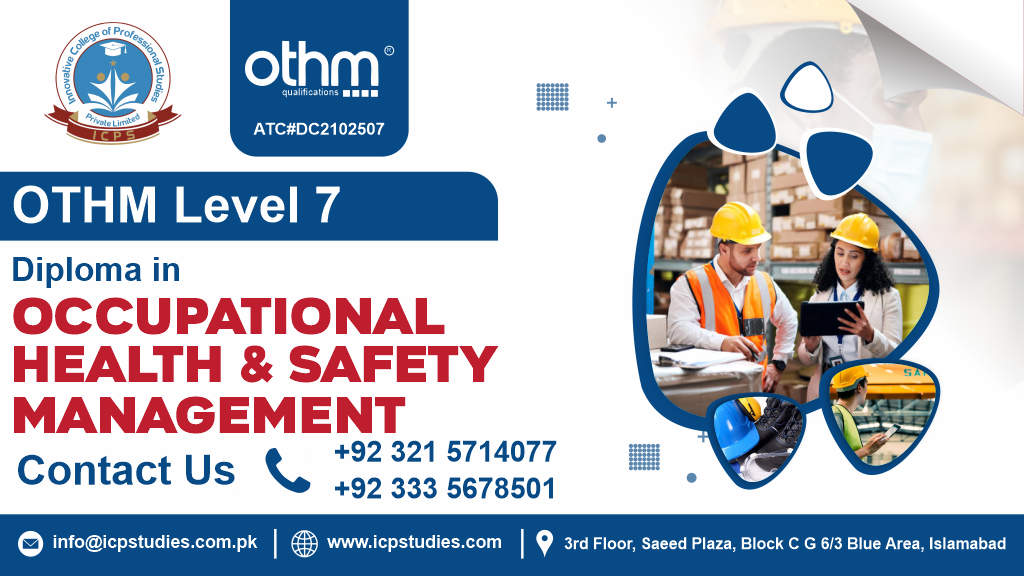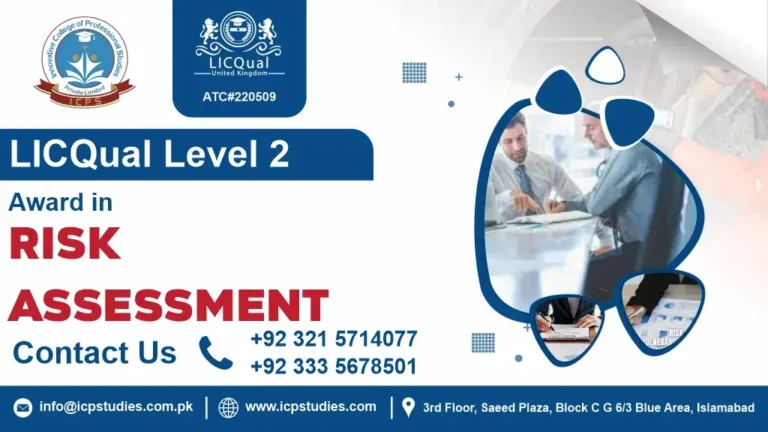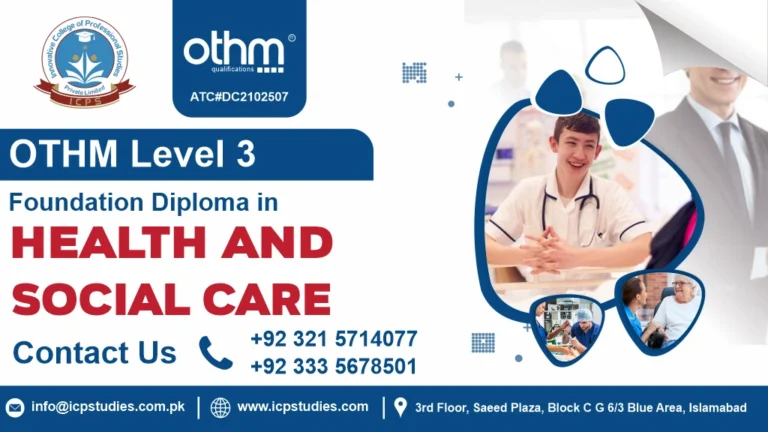Join the Elite Ranks of Occupational Health and Safety Professionals
Are you interested in progressing your career within Occupational Health and Safety Management? Your search ends here with the OTHM Level 7 Diploma in Occupational Health and Safety Management!
This comprehensive program offers a wealth of knowledge and practical skills to help you succeed in this demanding field. You’ll gain a deep understanding of the principles and practices of occupational health and safety management, as well as the legal and regulatory frameworks that govern it.
Our expert instructors bring years of industry experience to the classroom, providing you with practical insights and real-world examples that you can apply directly to your work. You’ll learn about risk assessment, hazard identification, incident investigation, and much more.
In addition, the program is designed to be flexible and convenient, with a range of delivery options to suit your schedule and learning style. You can choose from online, classroom, or blended learning, and you’ll have access to a wealth of resources and support to help you succeed.
So why wait? Invest in your future today with the OTHM Level 7 Diploma in Occupational Health and Safety Management. With this valuable qualification under your belt, you’ll be equipped to take your career to the next level and make a real difference in the world of workplace safety.
All About OTHM Level 7 Diploma in Occupational Health and Safety Management
Course Overview
The OTHM Level 7 Diploma in Occupational Health and Safety Management stands as a comprehensive program meticulously crafted to furnish learners with the knowledge and skills requisite for effectively managing and enhancing workplace safety standards. Ideal for professionals aspiring to elevate their careers in occupational health and safety, this course offers a robust curriculum covering a diverse array of topics.
Encompassing areas such as risk assessment, accident investigation, safety management systems, and legal compliance, the course equips students with a well-rounded understanding of the intricacies involved in fostering a safe work environment. Additionally, emphasis is placed on cultivating a positive safety culture, alongside honing effective communication and leadership strategies vital for proficient safety management.
Throughout the program, students undergo rigorous training aimed at enhancing critical thinking, problem-solving, and analytical abilities crucial for navigating the complexities of health and safety management. Upon successful completion, graduates emerge with the capability to identify hazards, assess risks, devise safety policies, and implement robust safety management systems.
Internationally recognized, the OTHM Level 7 Diploma in Occupational Health and Safety Management serves as a prestigious qualification, making it an invaluable asset for professionals seeking to operate within a global context. Tailored for individuals keen on augmenting their expertise in occupational health and safety management, this course serves as a pathway for career advancement in this specialized field.
In summary, the OTHM Level 7 Diploma in Occupational Health and Safety Management offers professionals a comprehensive platform to deepen their understanding of safety management and drive improvements within the workplace, positioning them as proficient leaders in the field of occupational health and safety.
Key Takeaways
The entry requirements for the OTHM Level 7 Diploma in Occupational Health and Safety Management typically include:
- Educational Background:
- A relevant master’s degree or equivalent qualification is often required.
- Alternatively, candidates with a Level 6 qualification in occupational health and safety or a related field may be considered.
- Professional Experience:
- A minimum of two years of relevant work experience in occupational health and safety or a related area is usually recommended.
- English Language Proficiency:
- Proficiency in English (both written and spoken) is required. Non-native speakers may need to provide evidence of their language skills (e.g., an IELTS score of 6.0 or equivalent).
- Motivation Statement:
- A statement outlining the applicant’s interest in occupational health and safety and how the course will benefit their professional development may be encouraged.
- Additional Qualifications:
- Relevant professional certifications (e.g., NEBOSH, IOSH) may strengthen the application but are not mandatory.
For the most accurate and specific information, it is advisable to consult the specific institution or provider offering the OTHM Level 7 Diploma in Occupational Health and Safety Management.
Mandatory Units
Learning Outcomes
The OTHM Level 7 Diploma in Occupational Health and Safety Management is a highly specialized and comprehensive program designed to equip students with the knowledge, skills, and competencies required to effectively manage health and safety issues in the workplace. Upon completion of this course, students will be able to:
Health and Safety Management Practice
- Apply practical strategies to implement effective health and safety management systems in various workplaces.
- Develop and maintain operational procedures to control hazards and minimize workplace risks.
- Monitor health and safety practices to ensure compliance with organizational policies and legal requirements.
- Coordinate with staff and management to promote safe work practices and adherence to procedures.
- Demonstrate effective communication skills to convey health and safety instructions and guidance.
Effectiveness of Health and Safety Management Systems
- Evaluate the design and implementation of health and safety management systems (HSMS) to ensure organizational effectiveness.
- Assess compliance with industry standards, regulations, and best practices in workplace safety.
- Identify gaps in HSMS processes and recommend improvements to enhance safety performance.
- Monitor key performance indicators (KPIs) to measure the success of health and safety initiatives.
- Foster a culture of continuous improvement to maintain effective and sustainable HSMS practices.
Factors Affecting Risk and Strategic Risk Intervention
- Analyze internal and external factors that influence workplace risk and safety performance.
- Conduct comprehensive risk assessments to identify potential hazards and evaluate their impact.
- Develop strategic risk intervention plans to mitigate identified risks effectively.
- Apply decision-making frameworks to prioritize risk management initiatives based on organizational objectives.
- Monitor and review risk interventions to ensure they remain relevant and effective over time.
Strategic Commitment to Health and Well-Being
- Understand the importance of strategic leadership in promoting employee health and well-being.
- Develop policies and initiatives to enhance workplace well-being and safety culture.
- Evaluate organizational practices to ensure alignment with health and well-being objectives.
- Encourage employee engagement and participation in well-being programs.
- Monitor and measure the effectiveness of strategic initiatives to improve health and safety outcomes.
Sustainability and Ethics in Health and Safety Practice
- Understand the ethical principles and responsibilities of health and safety practitioners.
- Implement sustainable practices in health and safety management to reduce environmental and organizational impact.
- Evaluate the ethical implications of health and safety decisions and interventions.
- Promote corporate social responsibility and responsible workplace practices.
- Develop strategies to integrate sustainability and ethics into organizational health and safety policies.
Advanced Research Methods
- Design and plan advanced research projects relevant to health and safety management.
- Apply qualitative and quantitative research methodologies to gather and analyze data effectively.
- Critically evaluate research literature to identify gaps, trends, and implications for practice.
- Interpret research findings to inform strategic decision-making in health and safety.
- Communicate research outcomes clearly through structured reports, presentations, and recommendations.
The OTHM Level 7 Diploma in Occupational Health and Safety Management course provides students with the necessary knowledge and skills to become competent health and safety professionals who can contribute to the success of any organization. Graduates of this program will be able to make a positive impact on workplace safety, reduce accidents and incidents, and improve overall organizational performance.
The OTHM Level 7 Diploma in Occupational Health and Safety Management is designed for:
Health and Safety Managers
- Professionals responsible for designing, developing, and implementing comprehensive health and safety policies within their organizations.
- Monitor workplace practices to ensure compliance with legal, regulatory, and industry-specific health and safety standards.
- Develop risk management strategies and initiatives to protect employees, assets, and organizational reputation.
- Lead training and awareness programs to ensure staff understand and follow health and safety procedures.
Safety Officers
- Individuals tasked with monitoring, evaluating, and managing workplace safety standards on a daily basis.
- Conduct inspections, audits, and risk assessments to identify potential hazards and implement corrective measures.
- Collaborate with management and teams to maintain a proactive safety culture.
- Keep up-to-date with changes in regulations and industry best practices to ensure ongoing compliance.
Risk Managers
- Professionals focused on identifying, assessing, and mitigating risks associated with workplace safety and operations.
- Develop and implement strategic risk management frameworks to minimize incidents and financial losses.
- Monitor key performance indicators (KPIs) and analyze risk trends to inform decision-making.
- Provide guidance to leadership teams on risk-related issues and mitigation strategies.
HR Professionals
- Human resource personnel involved in employee welfare, health, and safety compliance.
- Collaborate with safety teams to integrate health and safety policies into HR practices, including onboarding, training, and performance management.
- Ensure adherence to employment laws, occupational health regulations, and workplace safety standards.
- Promote employee engagement and participation in workplace safety programs.
Environmental Health and Safety (EHS) Professionals
- Individuals responsible for maintaining environmental health and safety standards across various industries.
- Implement and monitor environmental management systems to ensure compliance with environmental regulations.
- Conduct training and awareness programs on environmental safety, sustainability, and regulatory compliance.
- Collaborate with cross-functional teams to identify environmental risks and develop mitigation strategies.
Compliance Officers
- Professionals tasked with ensuring organizational adherence to health and safety legislation, codes of practice, and industry standards.
- Conduct audits and inspections to verify compliance with statutory and regulatory requirements.
- Develop corrective action plans and compliance strategies to address gaps or breaches.
- Serve as a liaison between the organization and regulatory authorities.
Occupational Health Professionals
- Individuals working in occupational health who wish to expand their expertise in health and safety management.
- Assess workplace environments and practices to prevent occupational illnesses and injuries.
- Advise management on health-related policies, ergonomics, and employee wellness programs.
- Integrate health assessments and monitoring into broader organizational safety initiatives.
Aspiring Leaders in Health and Safety Management
- Individuals aiming to advance their careers into senior health and safety management roles.
- Develop strategic leadership skills to influence organizational culture, policies, and decision-making.
- Lead cross-functional teams to implement effective health and safety management systems.
- Drive continuous improvement initiatives and promote a proactive, safety-first workplace culture.
Overall, the course targets individuals committed to enhancing their knowledge and skills in occupational health and safety, preparing them for leadership roles in this field.
FAQs Related to OTHM Level 7 Diploma in Occupational Health and Safety Management







